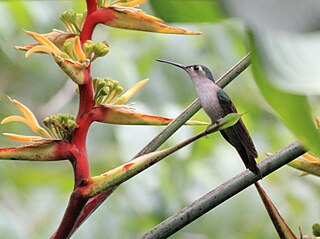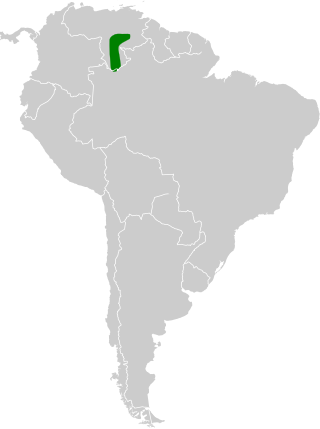
The violet sabrewing is a species of hummingbird in the "emeralds", tribe Trochilini of subfamily Trochilinae. It is found from Mexico to Panama.

The green-breasted mango or Prevost's mango is a species in subfamily Polytminae of the hummingbird family Trochilidae. It is found from eastern Mexico south through most of Central America, in Colombia and Venezuela, and as a vagrant in the United States.

The coppery-headed emerald is a small hummingbird in the "emeralds", tribe Trochilini of subfamily Trochilinae. It is endemic to Costa Rica.

The white-bellied emerald is a species of hummingbird in the "emeralds", tribe Trochilini of subfamily Trochilinae. It is found in Belize, Guatemala, Honduras, Mexico, and Nicaragua.

The azure-crowned hummingbird is a species of hummingbird in the "emeralds", tribe Trochilini of subfamily Trochilinae. It is found in Belize, El Salvador, Guatemala, Honduras, Mexico, and Nicaragua.

The blue-tailed hummingbird is a species of hummingbird in the "emeralds", tribe Trochilini of subfamily Trochilinae. It is found in Costa Rica, El Salvador, Guatemala, Honduras, Mexico, and Nicaragua.

The cinnamon hummingbird is a species of hummingbird in the "emeralds", tribe Trochilini of subfamily Trochilinae. It is found from northwestern Mexico to Costa Rica.

The wine-throated hummingbird is a species of hummingbird in tribe Mellisugini of subfamily Trochilinae, the "bee hummingbirds". It is found in El Salvador, Guatemala, Honduras, and Mexico.

The bumblebee hummingbird is a species of hummingbird in tribe Mellisugini of subfamily Trochilinae, the "bee hummingbirds". It is endemic to Mexico, but has occurred as a vagrant in the United States.

The wedge-tailed sabrewing is a species of hummingbird in the "emeralds", tribe Trochilini of subfamily Trochilinae. It is found in Belize, Guatemala, Mexico, and possibly Honduras.

The buff-breasted sabrewing, or sometimes Duida sabrewing, is a species of hummingbird in the "emeralds", tribe Trochilini of subfamily Trochilinae. It is found in Brazil and Venezuela.

The lazuline sabrewing is a species of hummingbird in the "emeralds", tribe Trochilini of subfamily Trochilinae. It is found in Colombia, Ecuador, and Venezuela.

The rufous-breasted sabrewing is a species of hummingbird in the "emeralds", tribe Trochilini of subfamily Trochilinae. It is found in Brazil, Guyana, and Venezuela.

The grey-breasted sabrewing is a species of hummingbird in the "emeralds", tribe Trochilini of subfamily Trochilinae. It is found in Bolivia, Brazil, Ecuador, the Guianas, Peru, and Venezuela.

The white-tailed hummingbird is a Near Threatened species of hummingbird in the "emeralds", tribe Trochilini of subfamily Trochilinae. It is endemic to southwestern Mexico.

The Pirre hummingbird, also somewhat misleadingly known as the rufous-cheeked hummingbird, is a Near Threatened species of hummingbird in the "emeralds", tribe Trochilini of subfamily Trochilinae. It is found in Panama and far northwestern Colombia.

The scaly-breasted hummingbird or scaly-breasted sabrewing is a species of hummingbird in the "emeralds", tribe Trochilini of subfamily Trochilinae. It is found in Belize, Colombia, Costa Rica, Guatemala, Honduras, Mexico, Nicaragua, and Panama.

The curve-winged sabrewing is a species of hummingbird in the "emeralds", tribe Trochilini of subfamily Trochilinae. It is endemic to Mexico.

The outcrop sabrewing or dry-forest sabrewing is a Vulnerable species of hummingbird in the "emeralds", tribe Trochilini of subfamily Trochilinae. It is endemic to eastern Brazil.

The Diamantina sabrewing is a Near-threatened species of hummingbird in the "emeralds", tribe Trochilini of subfamily Trochilinae. It is endemic to southeastern Brazil.
























